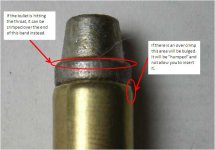kpmtns
Member
I have been reloading various calibers for years, and have extensively loaded 357 magnum loads with jacketed bullets. Recently, I loaded up a few 357 magnum rounds using Laser Cast 158g hard cast LSWC bullets to try something different. Cartridge length and OAL are perfect on them, but they won't chamber in my 686 or my GP100 or my Python because it appears the shoulders of the WC part of the bullets interfere with the chamber throats. I then loaded up a round using a very similar 158g LSWC from Colorado Bullet, and had the same problem.
Are you guys aware of any LSWC that have shorter shoulders so they can be loaded in normal length 357 brass? Or, do you recommend that I trim the brass down for use in these loads, and reduce the charge a bit to compensate for the decreased volume? I don't want to load up 38 special brass to higher pressures because I'd like to avoid bullet jump in the 357 magnum chambers. Any advice appreciated. Thanks.
Are you guys aware of any LSWC that have shorter shoulders so they can be loaded in normal length 357 brass? Or, do you recommend that I trim the brass down for use in these loads, and reduce the charge a bit to compensate for the decreased volume? I don't want to load up 38 special brass to higher pressures because I'd like to avoid bullet jump in the 357 magnum chambers. Any advice appreciated. Thanks.


